Spatial and Temporal Changes in Land Use and Landscape Pattern Evolution in the Economic Belt of the Northern Slope of the Tianshan Mountains in China
Abstract
1. Introduction
2. Materials and Methods
2.1. Area of Research Focus
2.2. Data Sources
2.3. Research Methods
2.3.1. Flexible Approach to Land Utilization
2.3.2. Land Use Transfer Matrix
2.3.3. Landscape Pattern Index
- (1)
- Class metrics
- (2)
- Landscape metrics
2.3.4. Grey Correlation Model
3. Results
3.1. Analysis of Land Use Change
3.1.1. Spatiotemporal Changes in Land Use Type
3.1.2. Fluctuating Alterations in the Types of Land Utilization
3.2. The Mutual Transformation Process between Land Use Types
3.3. Landscape Pattern Evolution Analysis
3.3.1. Altering the Attributes of the Landscape Structure on a Categorical Level
3.3.2. Modifying the Features of the Landscape Pattern on a Broader Scale
3.4. Correlation Analysis of Land Use Change and Landscape Pattern
4. Discussion
4.1. Research Consistency Analysis and Future Research Direction
4.2. Influence of Driving Factors on Land Use Pattern on the North Slope of Tianshan Mountains
5. Conclusions
Author Contributions
Funding
Data Availability Statement
Conflicts of Interest
References
- Yang, L.; Zhang, J.; Gong, E.; Liu, M.; Ren, J.; Wang, Y. Analysis of spatio-temporal land-use patterns and the driving forces in Xi’an City using GEE and multi-source data. Trans. Chin. Soc. Agric. Eng. 2022, 38, 279–288. [Google Scholar]
- Liu, X.Z.; Li, X.S.; Jiang, D.M. Landscape pattern identification and ecological risk assessment using land-use change in the Yellow River Basin. Trans. Chin. Soc. Agric. Eng. 2021, 37, 265–274. [Google Scholar]
- Yueriguli, K.; Yang, S.; Zibibula, S. Impact of land use change on ecosystem service value in Ebinur Lake Basin, Xinjiang. Trans. Chin. Soc. Agric. Eng. 2019, 35, 260–269. [Google Scholar]
- Le, C.; Wei, W. Spatiotemporal Changes in Land Use and Habitat Quality in A Typical Dryland Watershed of Northwest China. Ecol. Environ. Sci. 2022, 31, 1909–1918. [Google Scholar]
- Guo, Z.; Chen, F.; Liu, X.; Dai, Z. A method to improve the spatial accuracy of population grided data based on land use. Bull. Surv. Mapp. 2021, 12, 66–70. [Google Scholar]
- Shen, Z.; Zeng, J. Analysis of spatiotemporal patterns and evolution of regional thermal islands in Fujian Delta urban agglomeration during decade of 1996–2017. J. Saf. Environ. 2020, 20, 1567–1578. [Google Scholar]
- Dong, M.; Yang, L.; Su, l.; Chang, L.; Gao, D.; Zhou, J. On the value of ecosystem service and sensitivity based on the land-use pattern change in Daqing. J. Saf. Environ. 2014, 14, 330–333. [Google Scholar]
- Kuang, W.; Zhang, S.; Du, G.; Yan, C.; Wu, S.; Li, R.; Lu, D.; Pan, T.; Ning, J.; Guo, C.; et al. Remotely sensed mapping and analysis of spatio-temporal patterns of land use change across China in 2015–2020. Acta Geogr. Sin. 2022, 77, 1056–1071. [Google Scholar]
- Chen, H.; Yang, Q.; Peng, L.; Su, K.; Zhang, H.; Liu, X. Spatiotemporal evolution characteristics and scenario simulation of production-living-ecological space at county level in Three Gorges reservoir areas. Trans. Chin. Soc. Agric. Eng. 2022, 38, 285–294. [Google Scholar]
- Chen, X.; Zhan, Q.; Fan, Y. Classification and Evaluation Methods for Optimization of Land Use Efficiency at Village Level. Land 2023, 12, 710. [Google Scholar] [CrossRef]
- Sun, Q.; Sun, J.; Baidurela, A.; Li, L.; Hu, X.Y.; Song, T.W. Ecological landscape pattern changes and security from 1990 to 2021 in Ebinur Lake Wetland Reserve, China. Ecol. Indic. 2022, 145, 109648. [Google Scholar] [CrossRef]
- Liu, Y.L.; Jiao, L.M.; Liu, Y.F. Analyzing the effects of scale and land use pattern metrics on land use database generalization indices. Int. J. Appl. Earth Obs. Geoinf. 2011, 13, 346–356. [Google Scholar] [CrossRef]
- Jia, J.; Bai, J.; Deng, W. On the landscape pattern evolution and its motivating factors in Kangding City in the past two decades. J. Saf. Environ. 2017, 17, 1571–1577. [Google Scholar]
- Ou, G.; Peng, M.; Wang, C.; Duan, H.; Li, X. Landscape pattern impacts of the Ludila hydropower station construction in the middle reach of Jinsha River. J. Saf. Environ. 2011, 11, 153–157. [Google Scholar]
- Li, C.; Zhang, X.; Wu, Y.; Hao, F.; Yin, G. Change of landscape pattern and its impact on water conservation in Beijing-Tianjin-Hebei ecological barrier region. China Environ. Sci. 2019, 39, 2588–2595. [Google Scholar]
- Yohannes, H.; Soromessa, T.; Argaw, M.; Dewan, A. Impact of landscape pattern changes on hydrological ecosystem services in the Beressa watershed of the Blue Nile Basin in Ethiopia. Sci. Total Environ. 2021, 793, 148559. [Google Scholar] [CrossRef] [PubMed]
- Li, Y.; Wen, H.; Wang, F.X. Analysis of the Evolution of Mangrove Landscape Patterns and Their Drivers in Hainan Island from 2000 to 2020. Sustainability 2023, 15, 759. [Google Scholar] [CrossRef]
- Xu, L.L.; Yu, H.; Zhong, L.S. Evolution of the landscape pattern in the Xin’an River Basin and its response to tourism activities. Sci. Total Environ. 2023, 880, 163472. [Google Scholar] [CrossRef] [PubMed]
- Li, X. Recently Spatial-Temporal Landuse Changes in Northern Slope Economic Zone of Tianshan Mountains. J. Arid Land Resour. Environ. 2004, 02, 115–119. [Google Scholar]
- Shabiti, M.; Yusufu, D. Analysis on the Characteristics of Landuse Space-Time Change in the Econom ic Belt on the Northem Slope of Tianshan Mountain Xinjiang China. Areal Res. Dev. 2008, 27, 103–108. [Google Scholar]
- Wu, J.; Li, B.; Chong, J.; Zhang, X.; Xia, Y. Change of Land Use and Ecosystem Services Value in Different Landscape Belts in the Northern Slope of Tianshan Mountains. Resour. Sci. 2008, 5, 621–627. [Google Scholar]
- Zhang, R.; Li, S.; Wei, B.; Zhou, X. Characterizing production–living–ecological space evolution and its driving factors: A case study of the chaohu lake basin in China from 2000 to 2020. ISPRS Int. J. Geo-Inf. 2022, 11, 447. [Google Scholar] [CrossRef]
- Zhang, L.; Zhai, Z.; Zhou, Y.; Liu, S.; Wang, L. The Landscape Pattern Evolution of Typical Open-Pit Coal Mines Based on Land Use in Inner Mongolia of China during 20 Years. Sustainability 2022, 14, 9590. [Google Scholar] [CrossRef]
- Tong, X.R.; Yang, Q.Y.; Bi, G.H. Spatio-temporal Characteristics of Land Use Changes in Chongqing during 2000–2015. Resour. Environ. Yangtze Basin 2018, 27, 2481–2495. [Google Scholar]
- Yan, Z.; Wang, Y.; Li, R.; Zhang, S.; Li, W.; Zhang, Y. Spatiotemporal and evolutional characteristics and driving forces of land use/land cover in Xilingol Steppe during 2000–2020. Trans. Chin. Soc. Agric. Eng. 2022, 38, 275–284. [Google Scholar]
- Wang, L.; Zhang, Z.; Li, G.; Ma, F.; Chen, L. Landscape pattern change in Beijing fringe area and its impact on the ecosystem services:a case study in Niulanshan-Mapo town. Acta Ecol. Sin. 2018, 38, 750–759. (In Chinese) [Google Scholar]
- Su, K.; Wang, Y.; Sun, X.; Yue, D. Landscape Pattern Change and Prediction of Northeast Forest Belt Based on GIS and RS. Trans. Agric. Mach. 2019, 50, 195–204. [Google Scholar]
- Xu, X.; Du, Z.; Zhang, H.; Feng, L.; Shen, X. Quantitative analysis on driving forces of land use/cover change in north Shanxi province during 1986~2010. China Environ. Sci. 2016, 36, 2154–2161. [Google Scholar]
- Zhang, X.; Zhou, J.; Li, M. Analysis on spatial and temporal changes of regional habitat quality based on the spatial pattern reconstruction of land use. Acta Geogr. Sin. 2020, 75, 160–178. [Google Scholar]
- Lou, P.Q.; Fu, B.L.; Lin, X.C.; Bi, L.; Ma, R.X.; Tang, T.Y. Influence of Land Use Change on Ecosystem Service Value Based on GEE in the Beijing-Tianjin-Hebei Region from 1998 to 2018. Environ. Sci. 2019, 40, 5473–5483. [Google Scholar]
- Niu, H.B.; Wang, J.M.; Jing, Z.R.; Liu, B. Identification and management of land use conflicts in mining cities: A case study of Shuozhou in China. Resour. Policy 2023, 81, 103301. [Google Scholar] [CrossRef]
- Mamat, A.; Wang, J.P.; Ma, Y.X. Impacts of Land-Use Change on Ecosystem Service Value of Mountain-Oasis-Desert Ecosystem: A Case Study of Kaidu-Kongque River Basin, Northwest China. Sustainability 2021, 13, 140. [Google Scholar] [CrossRef]
- Zhang, M.; Wang, J.M.; Zhang, Y.; Wang, J. Ecological response of land use change in a large opencast coal mine area of China. Resour. Policy 2023, 82, 103551. [Google Scholar] [CrossRef]
- Liu, Y.; Li, L.; Ju, C. Spatio-temporal Evolution of Land Use and Ecological Service Value in Urban Agglomeration on Northern Slope of Tianshan Mountains. Bull. Soil Water Conserv. 2020, 40, 312–320. [Google Scholar]
- Nijat, E.; Mansur, S.; Yusup, M.; Malika, A. Temporal and spatial variation of LUCC in Jinghe oasis on the northern slope of Tianshan Mountains. J. China Agric. Univ. 2019, 24, 158–169. [Google Scholar]
- Chen, N.; Xin, C.L.; Tang, D.B.; Zhang, L.; Xin, S.J. Multi-scenario Land Use Optimization and Carbon Storage Assessment in Northwest China. Environ. Sci. 2023, 44, 4655–4665. [Google Scholar]
- Qiao, X.; Liu, H.; Liu, Y.; Gong, P.; Li, P.; Li, L. Analysis of spatial and temporal evolution and drivers of cropland in the economic zone of the northern slope of Tianshan mountain. Environ. Res. Commun. 2023, 5, 105010. [Google Scholar] [CrossRef]
- Pan, T.; Zhang, C.; Kuang, W.; Luo, G.; Du, G.; DeMaeyer, P.; Yin, Z. A large-scale shift of cropland structure profoundly affects grain production in the cold region of China. J. Clean. Prod. 2021, 307, 127300. [Google Scholar] [CrossRef]
- Sun, Y.; Liu, B.; Yang, G.; Du, Y.; Huang, H.; Wang, T.; Wang, J. Analysis of Spatiotemporal Evolution Patterns and Driving Forces of Reservoirs on the Northern Slope of the Tianshan Mountains in Xinjiang. Sustainability 2023, 15, 8824. [Google Scholar] [CrossRef]
- Reheman, R.; Kasim, A.; Ablat, H.; Duolat, X.; Xu, J.H. Research on the temporal and spatial evolution of habitat quality in urban agglomeration on the northern slope of Tianshan Mountains based on InVEST model. J. Ecol. Rural. Environ. 2022, 38, 1112–1121. [Google Scholar]
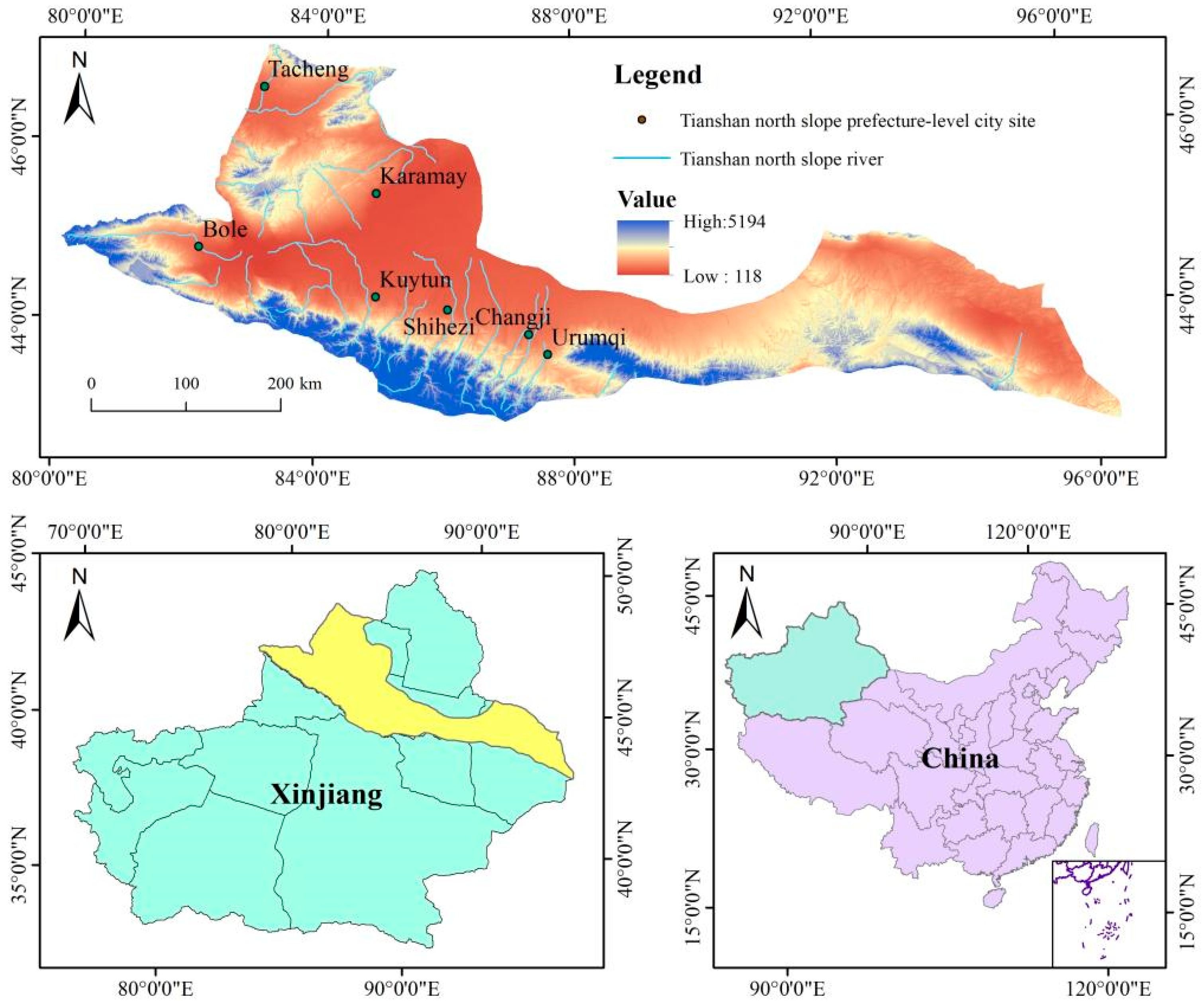
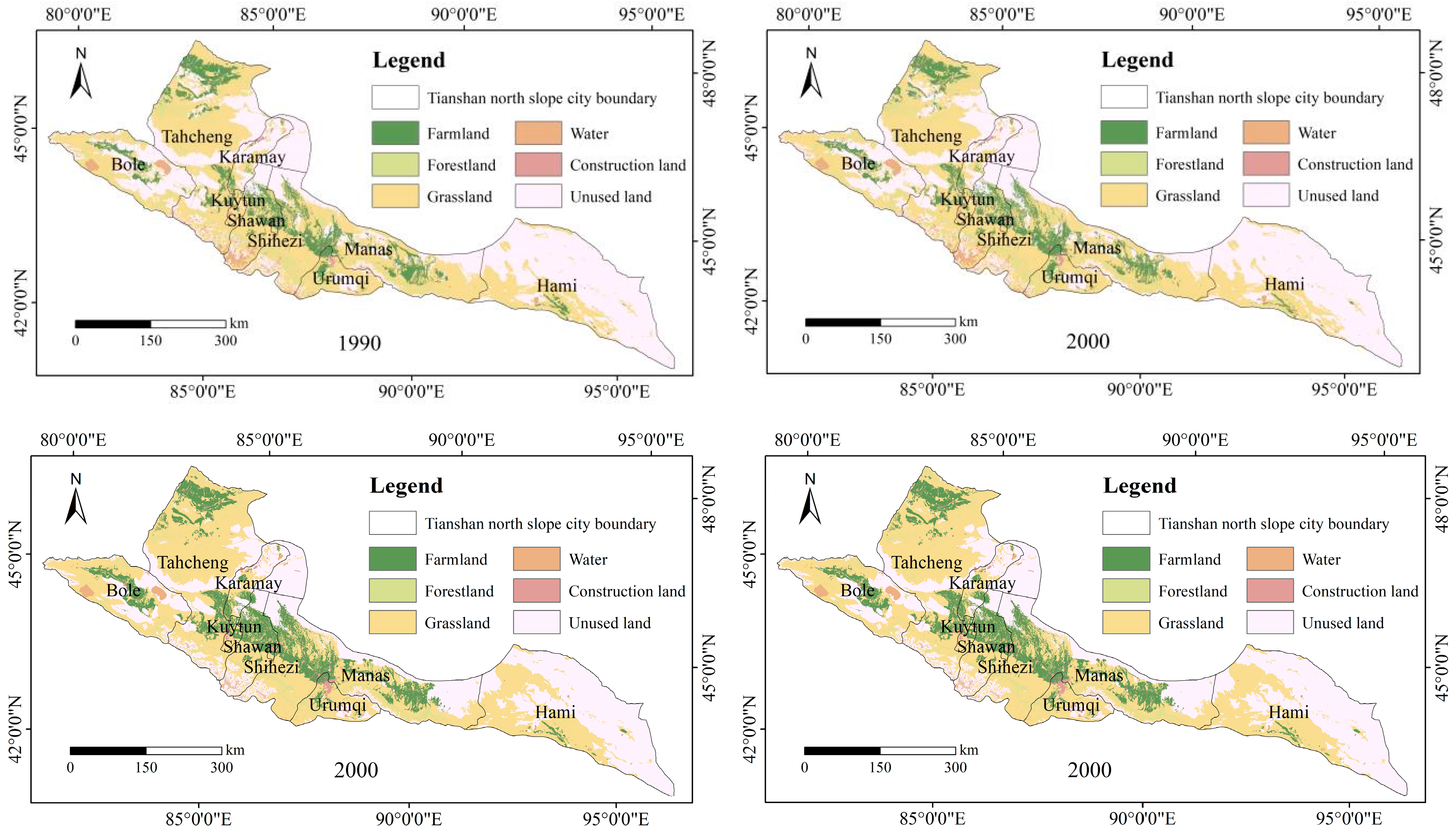
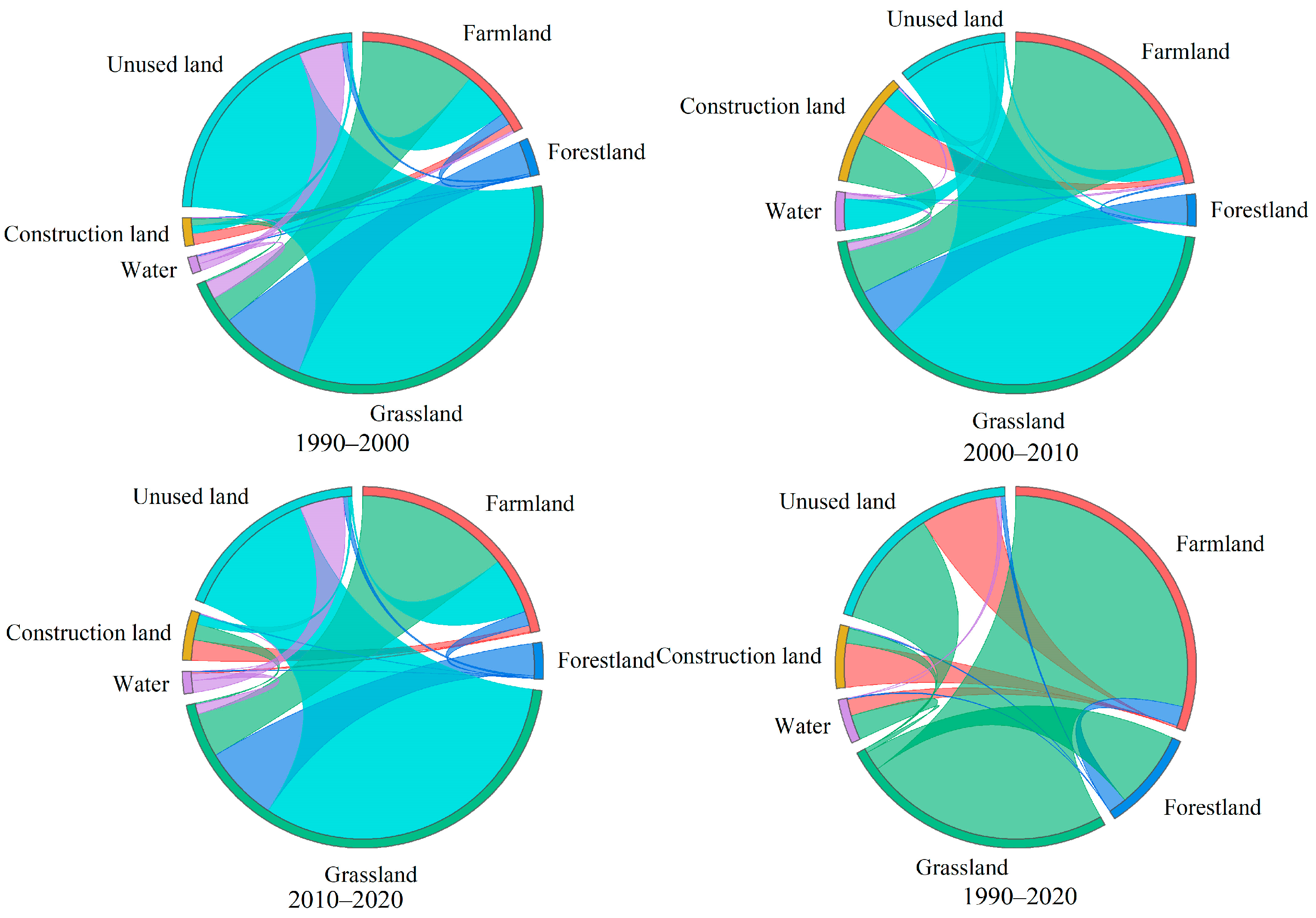


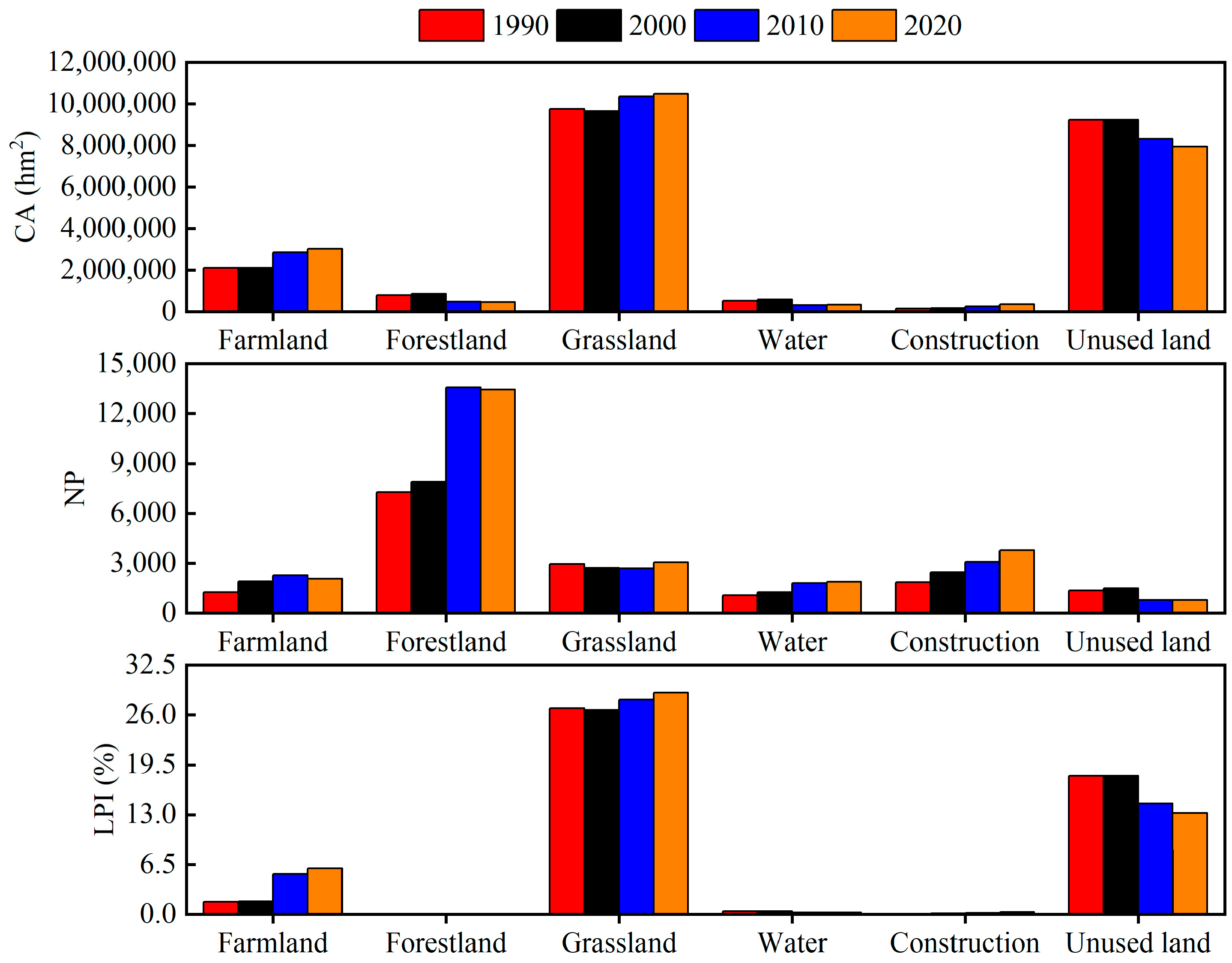
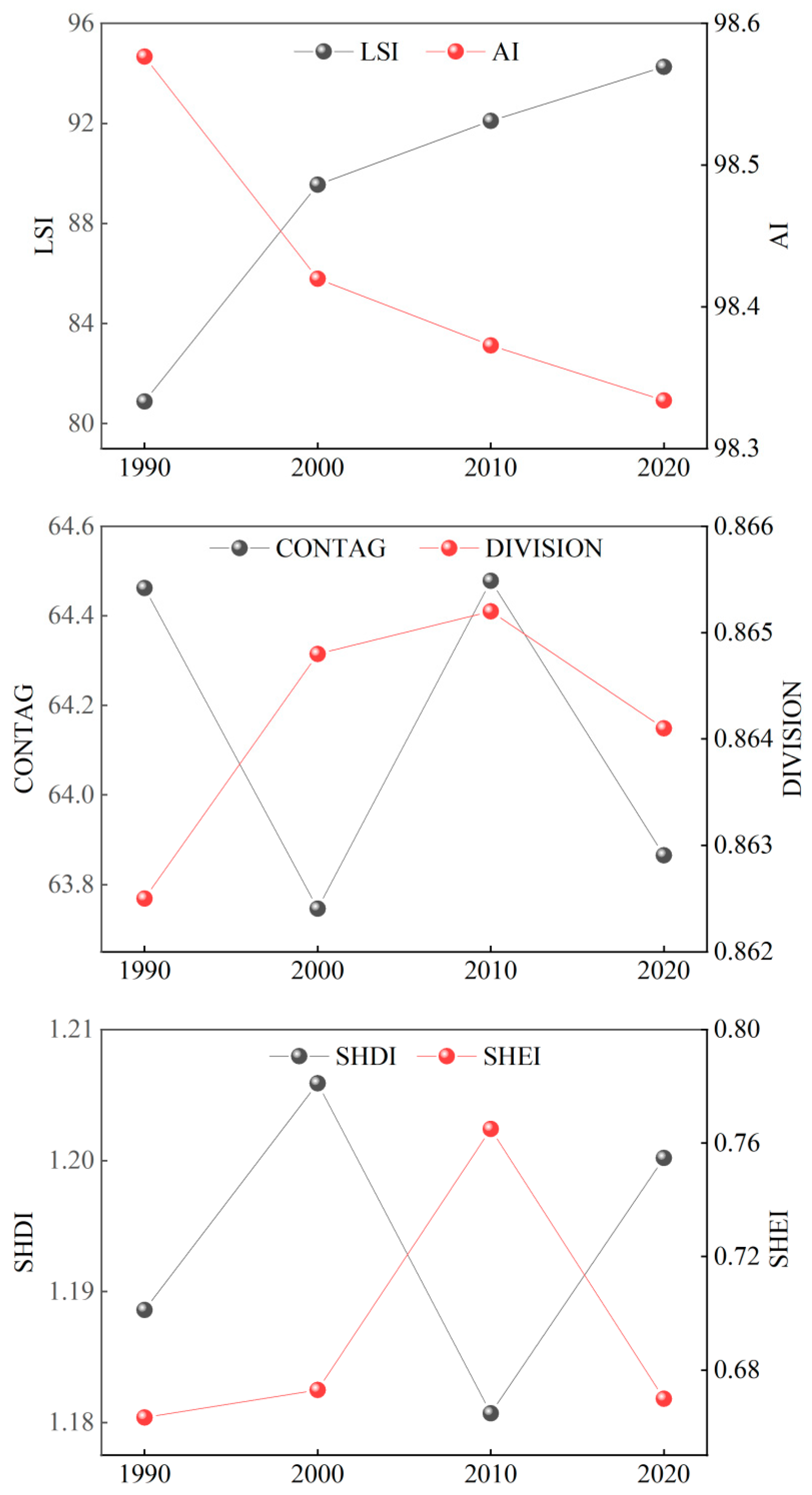
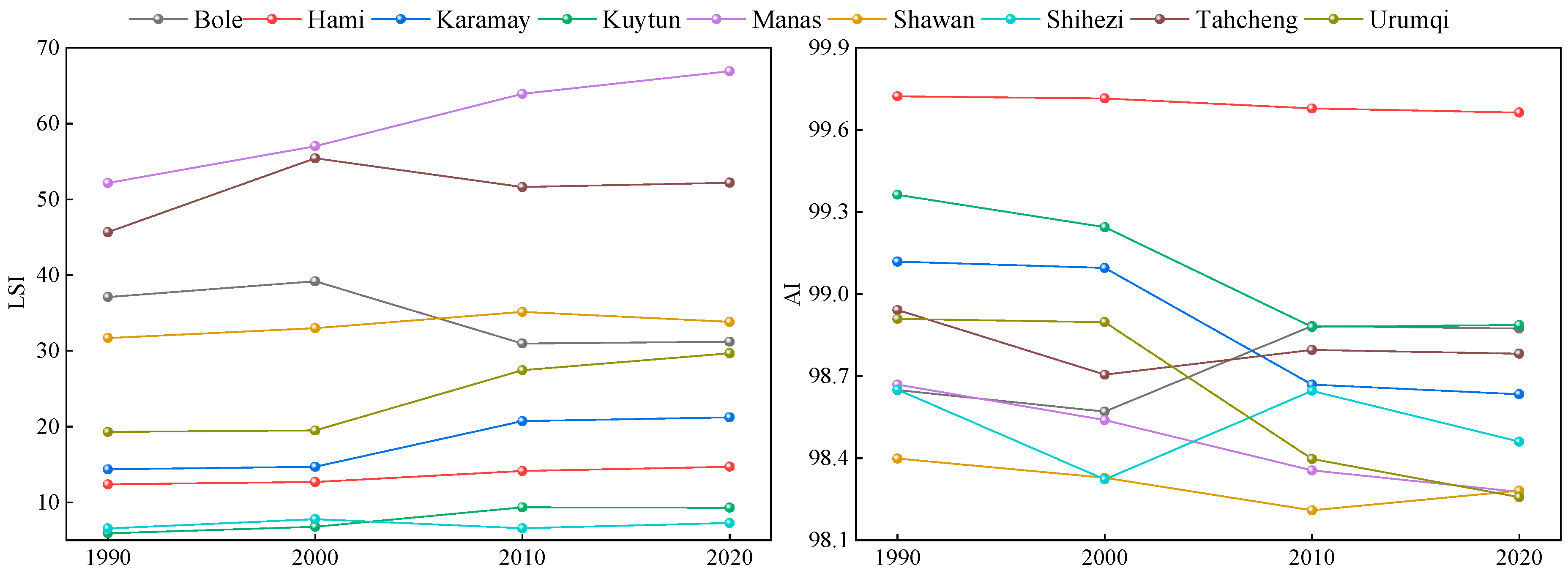
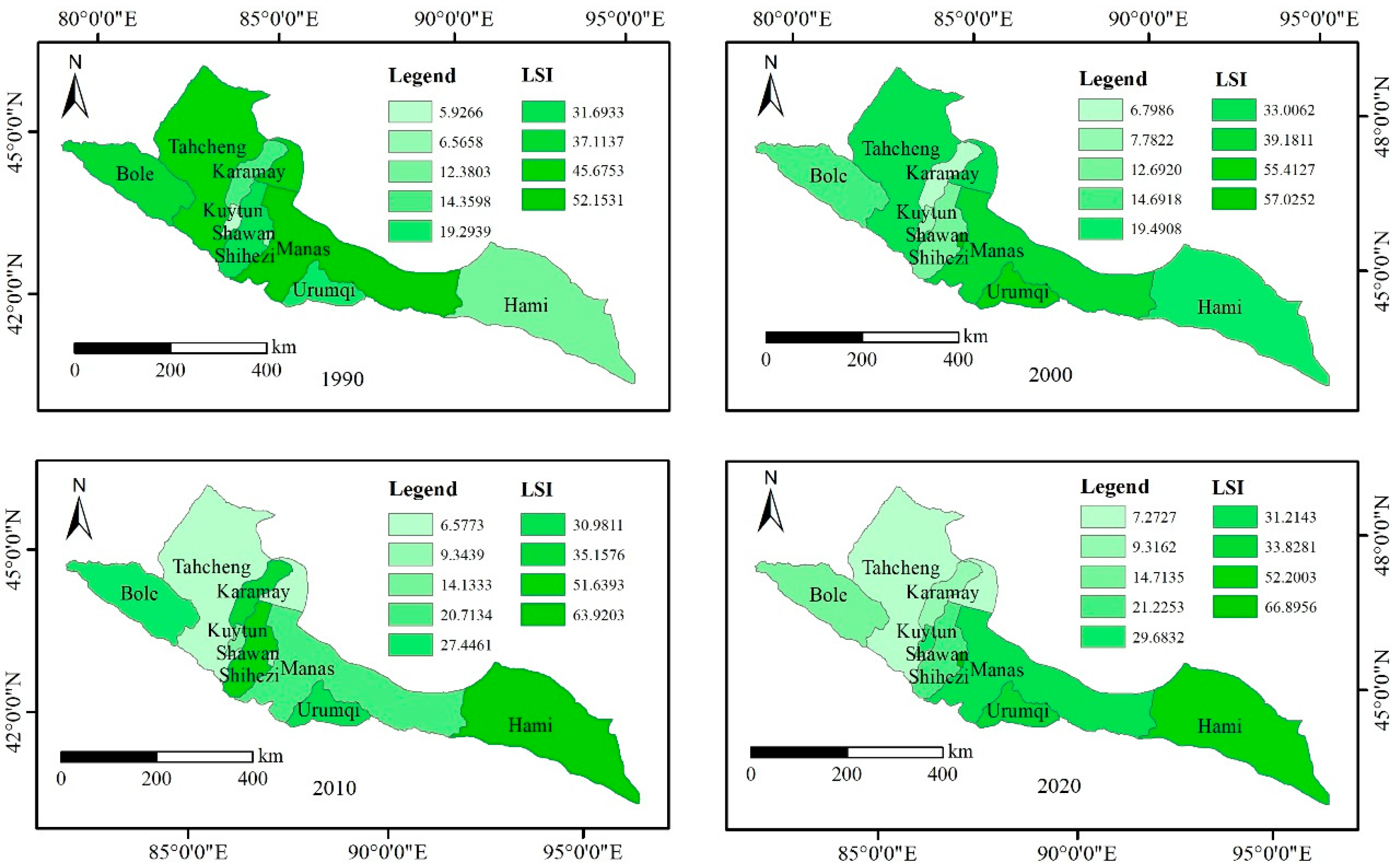

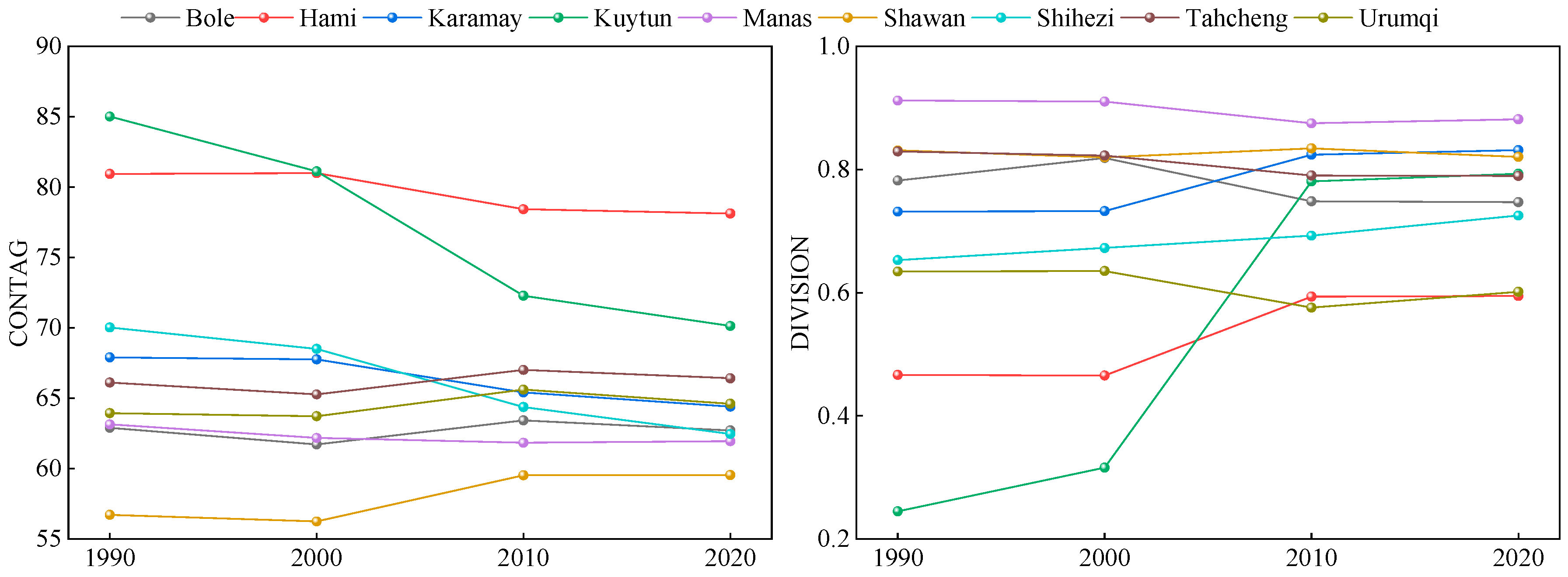
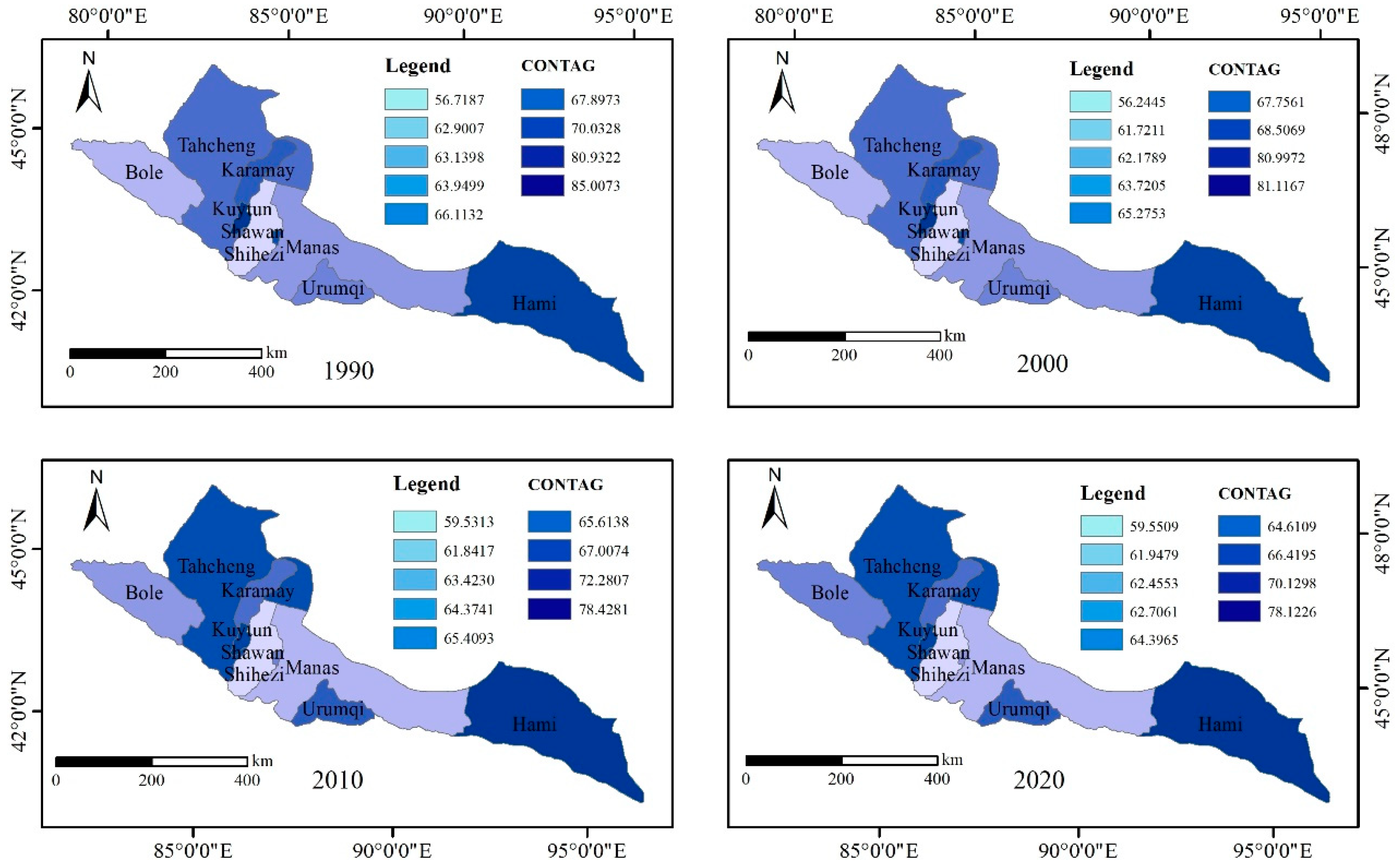
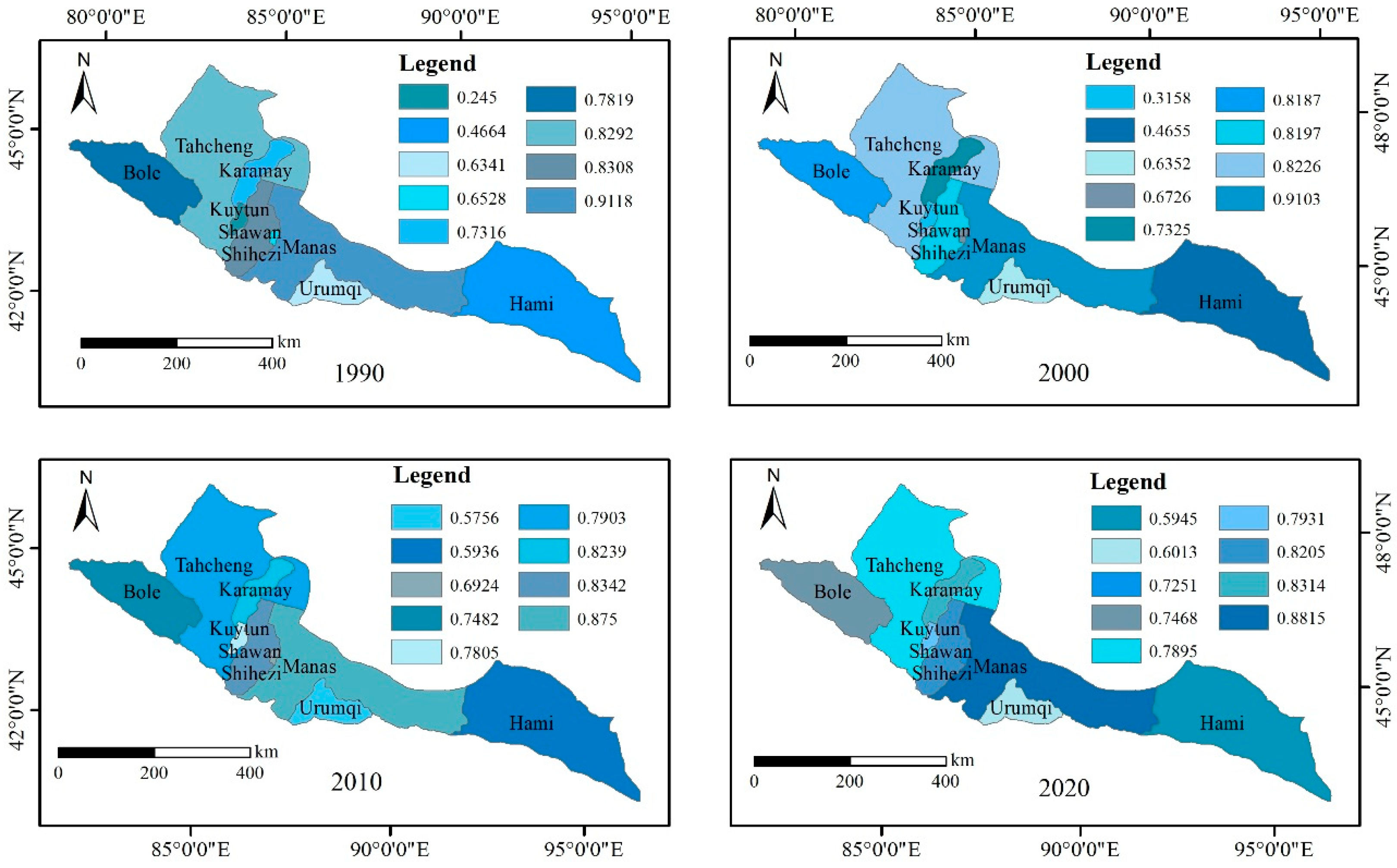

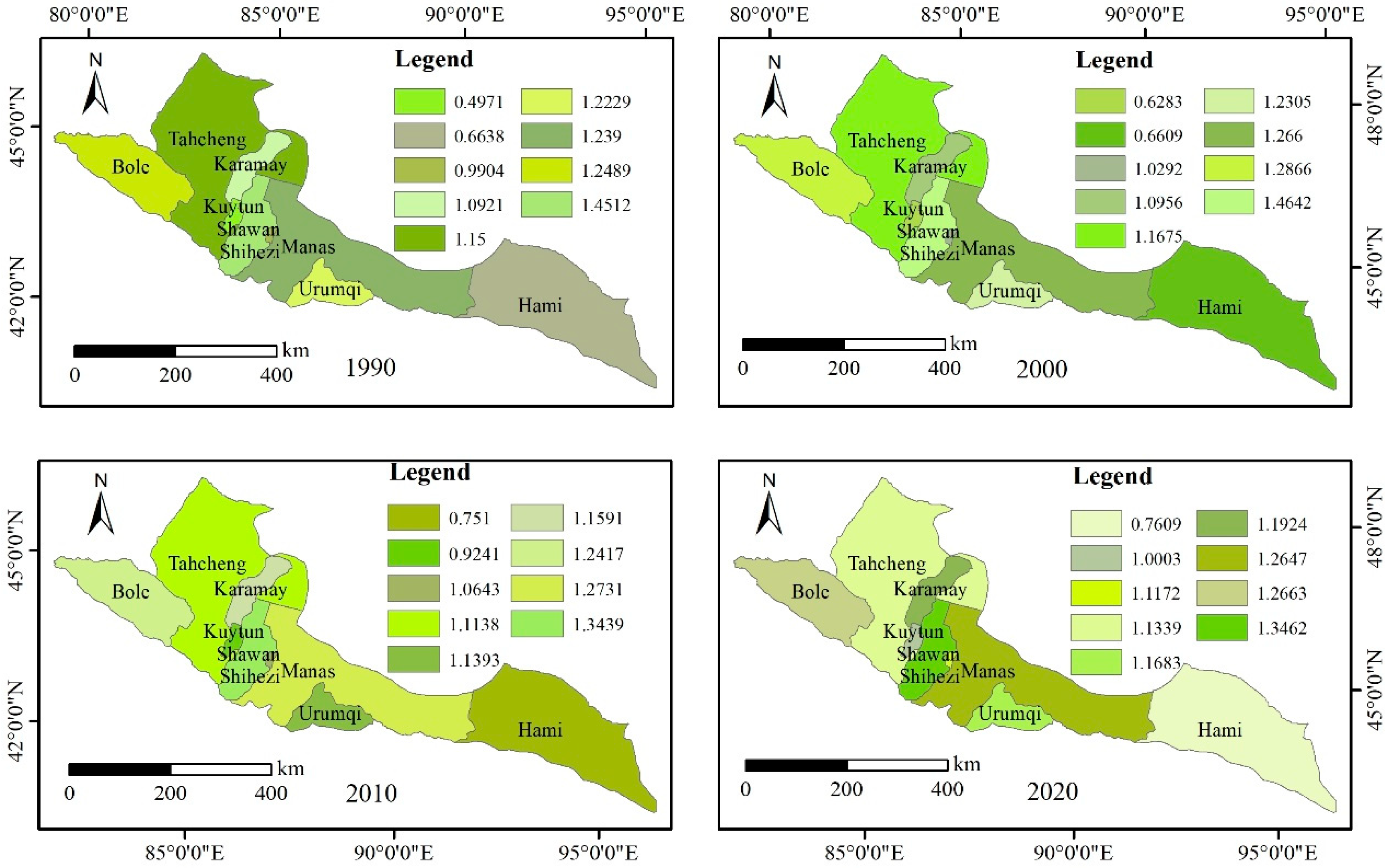


| Year | Change | Farmland | Forestland | Grassland | Water | Construction Land | Unused Land |
|---|---|---|---|---|---|---|---|
| 1990 | Area/km2 | 21,041.4 | 8047.7 | 97,580.4 | 5313.0 | 1439.6 | 92,441.0 |
| Ratio/% | 9.32 | 3.56 | 43.20 | 2.35 | 0.64 | 40.93 | |
| 2000 | Area/km2 | 20,997.9 | 8501.0 | 96,518.5 | 5813.9 | 1791.0 | 92,240.8 |
| Ratio/% | 9.30 | 3.76 | 42.73 | 2.57 | 0.79 | 40.84 | |
| 2010 | Area/km2 | 28,535.5 | 4782.5 | 10,3633.2 | 3276.4 | 2575.6 | 83,040.4 |
| Ratio/% | 12.64 | 2.12 | 45.89 | 1.45 | 1.14 | 36.77 | |
| 2020 | Area/km2 | 30,182.7 | 4548.7 | 10,4814.1 | 3453.8 | 3529.3 | 79,387.3 |
| Ratio/% | 13.36 | 2.01 | 46.40 | 1.53 | 1.56 | 35.14 |
| Year | Change | Farm Land | Forest Land | Grassland | Water | Construction Land | Unused Land |
|---|---|---|---|---|---|---|---|
| 1990–2000 | Variation/km2 | −43.50 | 453.25 | −1061.86 | 500.93 | 351.43 | −200.26 |
| Single dynamic attitude/% | −0.02 | 0.56 | −1.09 | 0.94 | 2.44 | −0.02 | |
| 2000–2010 | Variation/km2 | 7537.60 | −3718.50 | 7114.62 | −2542.47 | 784.61 | −9200.32 |
| Single dynamic attitude/% | 3.59 | −4.37 | 0.74 | −4.37 | 4.38 | −1.00 | |
| 2010–2020 | Variation/km2 | 1647.27 | −253.76 | 1180.95 | 177.40 | 953.70 | −3653.13 |
| Single dynamic attitude/% | 0.58 | −0.53 | 0.11 | 0.54 | 3.70 | −0.44 |
Disclaimer/Publisher’s Note: The statements, opinions and data contained in all publications are solely those of the individual author(s) and contributor(s) and not of MDPI and/or the editor(s). MDPI and/or the editor(s) disclaim responsibility for any injury to people or property resulting from any ideas, methods, instructions or products referred to in the content. |
© 2024 by the authors. Licensee MDPI, Basel, Switzerland. This article is an open access article distributed under the terms and conditions of the Creative Commons Attribution (CC BY) license (https://creativecommons.org/licenses/by/4.0/).
Share and Cite
Li, X.; Qin, D.; He, X.; Wang, C.; Yang, G.; Li, P.; Liu, B.; Gong, P.; Yang, Y. Spatial and Temporal Changes in Land Use and Landscape Pattern Evolution in the Economic Belt of the Northern Slope of the Tianshan Mountains in China. Sustainability 2024, 16, 7003. https://doi.org/10.3390/su16167003
Li X, Qin D, He X, Wang C, Yang G, Li P, Liu B, Gong P, Yang Y. Spatial and Temporal Changes in Land Use and Landscape Pattern Evolution in the Economic Belt of the Northern Slope of the Tianshan Mountains in China. Sustainability. 2024; 16(16):7003. https://doi.org/10.3390/su16167003
Chicago/Turabian StyleLi, Xiaolong, Da Qin, Xinlin He, Chunxia Wang, Guang Yang, Pengfei Li, Bing Liu, Ping Gong, and Yuefa Yang. 2024. "Spatial and Temporal Changes in Land Use and Landscape Pattern Evolution in the Economic Belt of the Northern Slope of the Tianshan Mountains in China" Sustainability 16, no. 16: 7003. https://doi.org/10.3390/su16167003
APA StyleLi, X., Qin, D., He, X., Wang, C., Yang, G., Li, P., Liu, B., Gong, P., & Yang, Y. (2024). Spatial and Temporal Changes in Land Use and Landscape Pattern Evolution in the Economic Belt of the Northern Slope of the Tianshan Mountains in China. Sustainability, 16(16), 7003. https://doi.org/10.3390/su16167003







